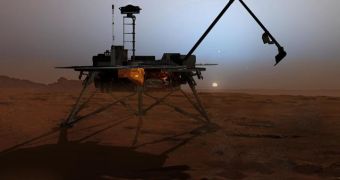A powerful dust storm, which recently covered the Martian skies, prevented sunlight from reaching Phoenix's hungered solar energy capturing device, and put the lander into a “Hospice Mode.” Technicians on Earth responsible with the mission could do nothing to prevent this from happening, although they previously hoped for the craft to survive a little bit longer within the reduced solar-energy conditions of the late Martian autumn.
The event caused energy levels to go below the critical point, somewhat reducing the life expectancy of the lander, and switching it to a mode in which it spent 19 hours being shut down and recharging its batteries. According to Barry Goldstein, the program manager from NASA's Jet Propulsion Laboratory in Pasadena, California, the lander may still be able to resist a few more weeks if the sky clears. Meanwhile, technicians are trying to upload a sequence of scientific operations to be performed until the mission ends.
“We're trying to squeeze the last bit of science we can out of the vehicle,” declared Goldstein for New Scientist. “We'll operate the same sequence every day. I call it Groundhog Day.” The last tasks required from Phoenix will include the execution of some atmospheric temperature and pressure measurements, by switching on a probe, previously buried in the soil to monitor underground ice formation. After that, a camera installed on the robotic arm will also be turned on and used to capture images of the surrounding region, as an alternative way to observe water and CO2 frost buildup around the lander.
The Surface Stereo Imager will provide bird's-eye snapshots of the immediate environment, while its laser ranger will scour the atmosphere, according to Peter Smith from the University of Arizona. The most recent Martian data will take an audio form and will be obtained by means of a small microphone. The main problem is synchronizing the Mars Reconnaissance Orbiter and the Mars Odyssey spacecraft that transmit data to and from the lander with the little time when Phoenix is still awake. We'll come back with details when the mission is over, and, again, when its results are made public in December.

 14 DAY TRIAL //
14 DAY TRIAL //